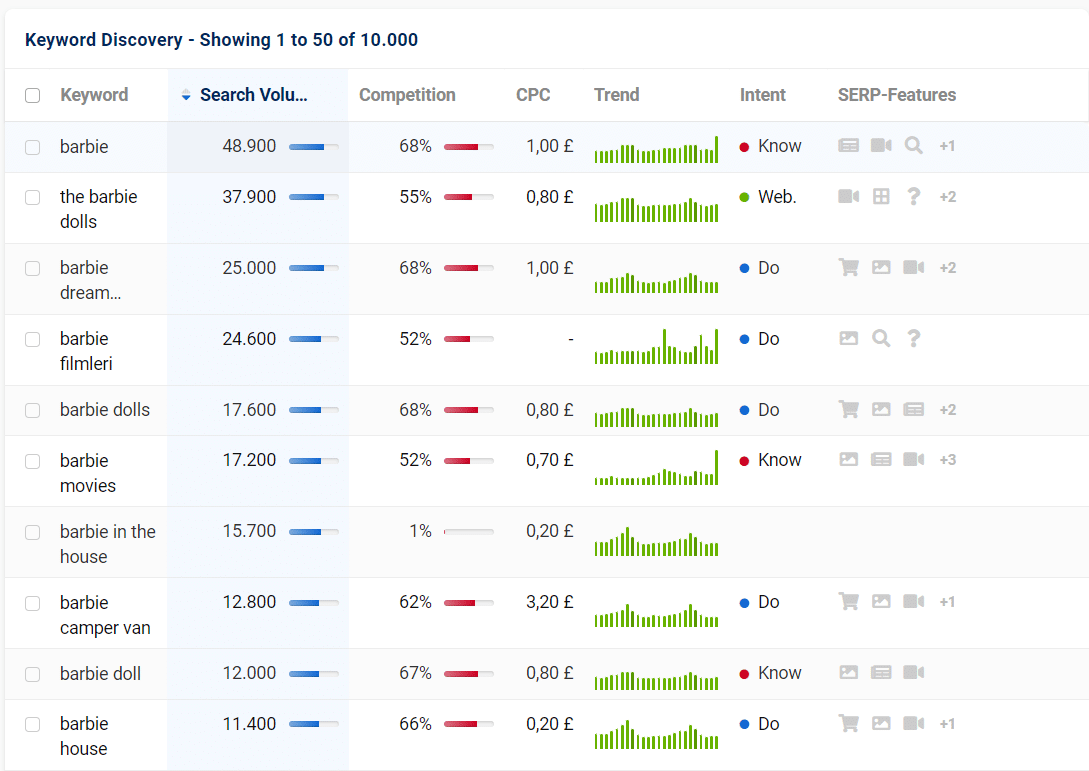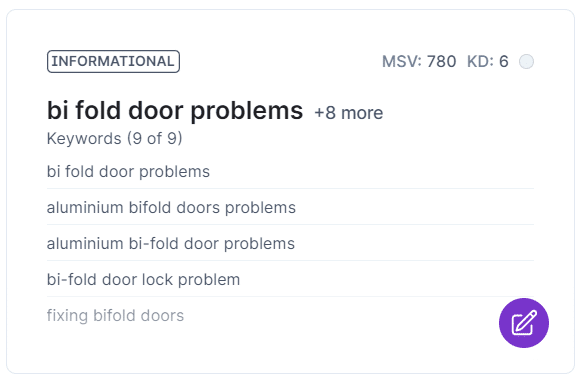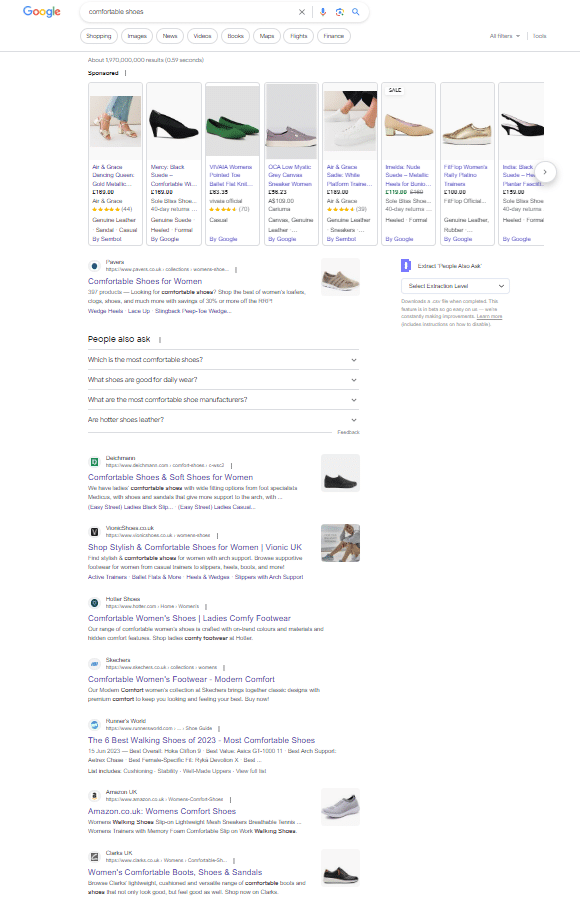
How to optimize for search intent: 19 practical tips
If you want to be relevant in the search engine results pages, creating content the aligns with search intent is important.
A user’s intent is the reason behind their query. Search engines aim to provide results that best satisfy the intent for a particular query.
Here are my tips on optimizing for search intent and improving your content to match what searchers are looking for.
1. Identify search intent
It’s simple but important to start by identifying the intent before you jump into optimization.
Broadly speaking you’ll classify search queries into one of the top 3 types of search intent:
- Navigational intent: The primary aim is to find a specific website.
- Transactional intent (a.k.a. commercial intent): The main goal is to buy something.
- Informational intent: The objective is to learn something.
If you’re working at scale, you can do this quickly using tools like Semrush, Ahrefs and Sistrix.
Their keyword research automatically includes intent classification to get things off the ground.

In the example above, you can clearly see the difference in intent between people looking for Barbie products to buy (with the commercial or ‘do’ intent) and queries relating to the movie with an informational (or ‘know’) intent.
Using these types of search intent to get a basic classification will set you off on the right track.
For example, you could find that you have a transactional page for a certain query when you could be creating or updating a rich informational resource to better match user intent.
It’s better to start with this information than discover it when you’ve already put a lot of work into optimizing a page, so this is an important step. It’s not always as obvious as you might think.
2. Put yourself in their shoes
Now you have a general intent classification, try to think like your intended audience.
We’ve all searched for different types of answers and know what good results look like.
Consider what you want to see and be honest about whether your current page or content provides that. If not, can you see where it’s lacking?
Getting a clear picture of the search intent optimization approach you’re aiming for makes it much easier to plan your content. Think like the user you’re trying to attract.
3. Review the SERPs
Take a break from research tools and use a search engine to look at what’s ranking for the topic you’re trying to optimize for. This is so important.
I’ve been surprised countless times by what I think people want and what is actually ranking. Sometimes we can be too close to our own products or industries we work in to see the bigger picture.
Look at the search results and assess what already ranks.
- What type of page is it?
- What is the content like?
- How does yours compare?
You might see that most of the content that satisfies search intent talks about something you’ve missed or formats things differently.
It won’t always be that obvious, but it’s well worth reviewing the SERPs and looking for similarities in the top-performing pages.
4. Analyze your current results
Look at your current ranking and click-through rate for your chosen query. If your content isn’t ranking well, this could indicate a search intent problem.
Examine your engagement metrics, such as bounce rate and time on page.
If people aren’t engaging with what’s on your page, you probably haven’t satisfied their search request as well as you could have.
To help with optimizing content, see if you can find a similar page with better engagement metrics and compare the differences. This can help you to spot opportunities for improvement.
5. Consider mixed intent
Broad keywords with a high search volume may often have various intents, so think about your different audiences.
Let’s take the phrase “comfortable shoes.” It’s most likely to be a person looking to buy some comfortable shoes. But they probably have more questions.
We can see this mixed intent coming through in the SERPs, with most of the top pages showing products to satisfy a transactional search intent but some providing information to fulfill informational search intent:
In this case, you’ll need to choose which user intent will most benefit you. For example, if you are running an ecommerce site, you’ll choose to optimize for commercial intent as it’s more likely to align with your goals.
6. Examine ambiguous intent
Sometimes, the user’s intent is ambiguous.
There could be different meanings behind the words they’ve used in their query, and they haven’t given enough detail to qualify this.
For example, if we type “sliding doors”’” into the search bar, you can see the following results:
The SERPs show:
- Shopping results for people who want to buy doors.
- Information about the 1998 film.
- PAAs about both the product and the film.
This is quite confusing, but the likelihood is that there will be a collection of people searching with the same phrase, but behind that are two completely different intents.
Search engines cannot tell exactly what the person intended, so they serve both results. If you want to rank, what do you do?
The best option is to satisfy the intent you’re interested in as best you can, as you can’t change these mixed results.
Someone looking for a product isn’t going to click on the film results, even if they rank higher.
So focus on making your page relevant to the traffic you want to gain, optimizing for this specific search intent.
7. Use AI to complete the picture
If you’re an in-house SEO working in a small team or simply want to kick start or verify your ideas, why not ask your favorite AI to give you a list of likely search intents for your main topic?
I’ve found this simple prompt suggested in how to optimize for entities a really useful starter:
“Ask GPT-4 to “provide a list of likely search intents for someone searching Google for [running shoes],” and you’ll get a list of ideas.”
This helps ensure you’re not working in a silo or overlooking some possible search intents that don’t resonate as much with you personally but are important to others.
It can help you to optimize your outline to cover many likely micro intents, creating a more well-rounded overall page or piece of content.
8. Update title tags and meta descriptions to match intent
Using the right language in title tags and meta descriptions can clearly indicate that your content satisfies the user’s search intent.
This could help improve click-through rates as searchers can see immediately that your page will provide what they need.
Including words like “buy” or “get” for transactional queries and “learn” or ‘discover’ for informational queries can help your result to stand out.
If we look at the query “how to make pancakes,” the top-ranking recipe sites use their title tags to guide users by including words like “easy,” “simple,” “best,” or “perfect” to capture the right audience for their page.

These words help to clarify the search intent, as less experienced bakers might be looking for a simple recipe, but others could be after a recipe to impress.
9. Use keyword clusters
While you’re researching your search query, take note of keyword clustering.
A single page rarely ranks for just one query, so keyword clustering tools can help create a bigger picture regarding search intent.
For example, if you’re trying to create content to satisfy the specific phrase “bifold door problems,” the keyword cluster below can help to identify which problem areas to cover:

So if your content is missing the mark, you can consider adding more detail about aluminum options and problems with the locks to fulfill that keyword intent better.
10. Check the SERP features
When you carry out a Google search, pay attention to the SERP features you see. Is there a People also ask box, knowledge panel, an image pack or a local pack?
These features give an indication of the search intent. They’re there to help users find what they want so pay attention to what’s available.
11. Use the SERP features
Now you’ve seen the search features, can you use these? For example, what are the PAAs shown in the search engine results? Could your informational content better satisfy search intent if you include the answers to some of these?
Perhaps an image pack indicates that your content might benefit from more visuals. Plenty of video results could suggest that including your own unique video might enrich your page.
12. Use the right format
Formatting is important in helping people process information and discover answers for themselves. And that makes it vital when it comes to search intent too.
For example, if the user’s primary aim is to browse products, their intent will be best satisfied with a product listing page.
Let’s say we’re searching "dresses for weddings." Our aim is probably to look at the styles available and decide what we like and what will suit us.
So it’s not surprising that all the top results are product listing pages:

No other page format comes in the top results. This only deviates when more informational articles appear much lower down the results page.
A category page that directed users to subcategories like midi, maxi, mini or different colored dresses rather than listing products would be less likely to satisfy the intent of this type of shopper.
This is because they are unlikely to have reached that stage in their decision-making process yet. They don’t know what type of dress they need and are searching for inspiration, so while the overall intent is to buy a product, the micro-intent is to browse.
13. Include supporting entities
The concept of matching search intent is straightforward, but creating relevant content that satisfies a user’s needs is much more complex.
Intent and entities are inextricably linked. Entities help search engines determine the meaning of content, and what content means confirms whether it satisfies a certain intent.
The best way to demonstrate that you satisfy intent is to really understand the topic and the pain points of your target audience. Then, create high-quality content that provides solutions.
To do this, you’ll need to research related entities and include them in your content, showing a depth and breadth of knowledge about the topic in question.
14. E-E-A-T
If you really want to satisfy search intent you’re going to need some experience, expertise, authoritativeness and trust.
After all, if someone is looking for information on a complex or niche subject, they’re more likely to trust an expert's advice over a generalist's.
You can optimize for search intent by improving on these factors. If you have a more experienced person available within your organization, ask them to contribute, review or fact-check your content.
You can also expand on E-E-A-T factors by asking subject matter experts from outside your company for quotes, contributions or analysis.
15. Check your language
Just as using the right language in title tags and meta descriptions can be beneficial, so can carrying it through the rest of your copy.
If you write in a way that demonstrates you’re answering a question or fulfilling a need to a reader, they are more likely to engage with your content and feel that you have satisfied their query.
In some cases, this might be as simple as adding language that reflects the intent such as ‘buy now’ or ‘for sale’ within transactional pages.
However, you might need to review the readability to make sure your content communicates clearly and effectively. Consider the words you use and whether they align with the intent. Address pain points directly and make it clear you are doing so.
16. Get human feedback
Once you’re clear about the intent and what you’re trying to achieve, ask others to read and review your content for this intent.
Do they feel it satisfies the intent? Can they suggest any improvements?
After all, your content is for real people, so it’s important to get another perspective. This is ideal if you can get your page reviewed by your target audience.
But if it isn’t possible, simply asking one or two colleagues to review your content might be enough to identify areas for improvement.
17. Get AI feedback
If you’re short on time, or in a small team, you could ask AI to review for intent. It’s always a good sense check anyway and might give you some useful optimization ideas.
For example, I’ve added some of my own content and asked ChatGPT to:
“Create a list of search intent that it fulfills. List the intents in bullet points along with the sentiment”.
This is a good sense check to see if it identifies the intent you’d aimed for. You can even ask a simple question like:
“Does this copy satisfy a transactional intent?”
And ask follow-up questions based on the response. This can help you to generate ideas for improving your content based on intent.
18. Check your calls to action
Have you included CTAs in your content and do these match the intent?
While "buy now" might be your go-to for transactional intent, you might use phrases like "learn more" or "sign up" on more informative pages.
Review any calls to action to see if they support the intent. Adjust these if necessary.
19. Continuously improve
Search intent and search engine’s understanding of it can often change.
Like any optimization work, it’s best to keep reviewing and improving your top pages to ensure they still fulfill the intent.
Remember, you’re trying to help users accomplish their purpose
When you’re optimizing for search intent, you won’t go too far wrong if you put your users at the heart of everything you do.
That being said, not every user is the same and the intent behind queries, especially broader ones, can be nuanced.
Search engines are already working with this type of information at scale and serving the results they determine to best satisfy the intent of a query for most users.
A combination of thorough research in and outside the SERPs, planning, execution and feedback are all essential to ensure you fulfill user intent and create helpful and useful content.
The post How to optimize for search intent: 19 practical tips appeared first on Search Engine Land.
from Search Engine Land https://searchengineland.com/optimize-search-intent-tips-430857
via free Seo Tools

